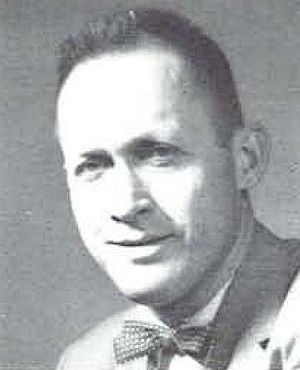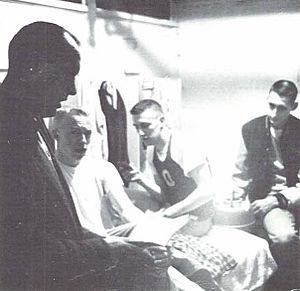Bill Bowerman facts for kids
Quick facts for kids
Bill Bowerman
|
|
|---|---|
 |
|
| Born |
William Jay Bowerman
February 19, 1911 Portland, Oregon, U.S.
|
| Died | December 24, 1999 (aged 88) Fossil, Oregon, U.S.
|
| Alma mater | University of Oregon |
| Occupation | Coach Co-founder of Nike, Inc. |
| Spouse(s) |
Barbara Young Bowerman
(m. 1936) |
| Children | Jon Bowerman William J. "Jay" Bowerman, Jr. Thomas Bowerman |
| Parent(s) | Jay Bowerman |
| Military career | |
| Allegiance | |
| Service/ |
|
| Years of service | 1942–1945 |
| Rank | Major |
| Battles/wars | World War II |
| Awards | Silver Star Bronze Star (4) |
William Jay Bowerman (born February 19, 1911 – died December 24, 1999) was an American track and field coach. He also helped start the famous sports company, Nike, Inc..
During his career, he trained many top athletes. These included 31 athletes who went to the Olympic Games. He also coached 51 "All-Americans" (top college athletes) and 12 American record holders. He helped 22 athletes become NCAA champions. He even coached 16 runners who could run a mile in under four minutes.
Bill Bowerman coached at the University of Oregon for 24 years. His teams, called the "Ducks," had winning seasons almost every year. They won four national titles in college sports (NCAA titles). As a co-founder of Nike, he created popular shoe designs. These include the Cortez and Waffle Racer. He helped Nike grow from selling other brands' shoes to making its own.
Contents
Early life and military service
Bill Bowerman was born in Portland, Oregon. His father, Jay Bowerman, used to be the governor of Oregon. After his parents divorced, Bill moved to Fossil, Oregon. He had an older brother and sister. He also had a twin brother who sadly died young.
Bill went to high school in Medford, Oregon. He played in the school band and was on the state champion football team. He met his future wife, Barbara Young, in high school.
In 1929, Bill went to the University of Oregon. He played football and studied journalism. He also joined the track team. After college, he taught biology and coached football. He married Barbara Young in 1936. They had three sons: Jon, Jay Jr., and Tom.
Serving his country
Bill Bowerman joined the United States Army after the Pearl Harbor attack in 1941. He became a 2nd Lieutenant. He was part of the 10th Mountain Division. This division trained in the mountains of Colorado.
He helped organize supplies for the troops. He also took care of the mules used to carry supplies in the mountains. In 1944, his division went to Italy. Bill was promoted to Major. He helped negotiate with German forces before the war ended in Italy. For his brave service, he received the Silver Star and four Bronze Stars. He left the army in 1945.
Coaching career
After World War II, Bill Bowerman returned to coaching. In 1948, he became the head track coach at the University of Oregon. This was his old college.
University of Oregon success
Bowerman's "Men of Oregon" teams were very successful. They won 24 individual national titles. They also won four NCAA team championships (in 1962, 1964, 1965, and 1970). His teams finished in the top 10 nationally 16 times in 24 years. He coached 33 Olympians and 64 "All-Americans." His teams had an amazing record of 114 wins and only 20 losses in dual meets. They had 10 undefeated seasons.
In 1962, one of his teams set a world record for the 4-mile relay race. Another team broke that record six years later. Some famous athletes he coached include Steve Prefontaine, Phil Knight (who later co-founded Nike with him), and Mel Renfro. Renfro became a famous football player in the NFL.
Bill Bowerman preferred to be called a teacher, not just a coach. He wanted his athletes to do well in school. He also taught them to use lessons from track in their daily lives.
He retired as head coach in 1973. His assistant, Bill Dellinger, took over.
Olympic coaching
Bill Bowerman created a special training program for the 1968 Mexico City Olympic Games. This program helped athletes get used to the high altitude. Because of this success, he was chosen to be the head track and field coach for the 1972 Munich Olympics.
During the 1972 Munich Olympics, a dangerous event happened. Bill Bowerman helped protect American athletes, especially those who were Jewish, by calling for security.
Running for fitness
In 1962, Bill Bowerman visited New Zealand. There, he learned about "running" as a way for anyone to stay fit, even older people. His friend, coach Arthur Lydiard, had a running club. Bowerman brought this idea back to the United States.
He started writing articles and books about running. He also created a running program in Eugene, Oregon. This program became a model for fitness programs across the country. In 1966, he published a book called Jogging with a doctor named W.E. Harris. This book sold over a million copies! It helped start the huge jogging trend in the United States.
Bill Bowerman, Phil Knight, and Geoff Hollister also started a running team called Athletics West in 1977. This team helped young American athletes keep competing after college. Its success helped inspire the "running boom" of the 1970s.
Nike

Bill Bowerman often experimented with shoes for his athletes. Otis Davis, an Olympic gold medalist he coached, said Bowerman made custom shoes for him. He even used a waffle iron to create new shoe soles!
In 1964, Bowerman teamed up with Phil Knight. Knight had been a runner under Bowerman in college. They started a company called Blue Ribbon Sports. This company later became Nike, Inc.. At first, they imported running shoes from Japan.
Bowerman focused on designing better athletic shoes. He stayed in Eugene, coaching. Knight handled the business side from Portland. They started as equal partners. But Bowerman suggested Knight have a slightly larger share (51-49). This was to make sure one person could make final decisions and avoid disagreements.
Bowerman's ideas led to the famous "Nike Cortez" shoe in 1968. It quickly became a best-seller. He is also famous for using his wife's Belgian waffle iron to create a new kind of shoe sole. He wanted a sole that would grip well but be very lightweight.
His experiments led to the "Moon Shoe" in 1972. It was named because its waffle pattern looked like astronaut footprints on the moon. This design was improved to create the "Waffle Trainer" in 1974. This shoe helped Nike grow incredibly fast.
While working on shoe designs, Bowerman used strong glues and chemicals. Sadly, this caused him some health problems, affecting his ability to walk easily.
He was obsessed with making running shoes lighter. He believed that removing just one ounce (about 28 grams) from a shoe would save a runner a lot of energy over a mile.
Phil Knight once said, "If coach (Bowerman) isn't happy, Nike isn't happy." This shows how important Bowerman was to the company. In the late 1970s, Bowerman reduced his role at Nike. He started giving his shares in the company to other employees.
Legacy
Bill Bowerman is honored in many ways. He is a member of the National Distance Running Hall of Fame and the National Track and Field Hall of Fame. He is also in the National Inventors Hall of Fame.
A statue of him and his stopwatch stands at Hayward Field at the University of Oregon. This is where many track events are held. A movie called Without Limits was made in 1998 about him and his famous runner, Steve Prefontaine. The main headquarters for Nike is on Bowerman Drive, named after him. Nike also created the "Bowerman Series" of running shoes in his honor.
In 2009, a special award was created called The Bowerman. It is given to the best male and female college track and field athletes each year.
Death
Bill Bowerman passed away on December 24, 1999, at the age of 88. He died at his home in Fossil, Oregon.
See also
- List of teachers portrayed in films
- Without Limits


